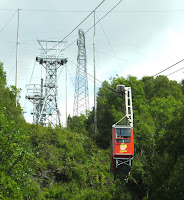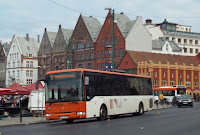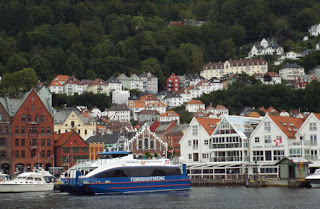Bergen, on Norway's west coast, is Norway's second largest city with around a quarter of a million people living there. It is a popular tourist destination, partly as a gateway to the Norwegian fjords.
Bergen is one of three Norwegian cities with a tram system, as well as being home to the country's only trolleybus system. The public transport system in and around Bergen is coordinated by Skyss. I visited Bergen in July 2017.
Bergen is one of three Norwegian cities with a tram system, as well as being home to the country's only trolleybus system. The public transport system in and around Bergen is coordinated by Skyss. I visited Bergen in July 2017.
 Trams had operated in Bergen until 1965, when the system closed. Following a break of 45 years, trams returned to Bergen's streets in 2010.
Trams had operated in Bergen until 1965, when the system closed. Following a break of 45 years, trams returned to Bergen's streets in 2010.
Although they system currently comprises only one line, this has been extended out from the city since it opened. It now links the city centre with Bergen's airport.
 From the city centre terminus, the tram line initially run on-street. However, as the line head into the suburbs, it is on its own reserved track.
From the city centre terminus, the tram line initially run on-street. However, as the line head into the suburbs, it is on its own reserved track.It is not just the tram route which has been extended since opening in 2010. The trams have themselves been lengthened with additional sections to provide greater capacity.
As a reminder of Bergen's previous tram system, a heritage tram operates on occasional Sundays over a short section of line leading from the technical museum.
 There is a project to extend the heritage line into the city centre, with some tracks already restored.
There is a project to extend the heritage line into the city centre, with some tracks already restored.
The Bergen's Electric Tramway site (mainly in Norwegian only) gives further information about the heritage tram.
 Trolleybuses were introduced to Bergen's streets in the 1950s, as the previous tram system was declining. One trolleybus route survives today, linking the city centre with Birkelundstoppen to the south of the city.
Trolleybuses were introduced to Bergen's streets in the 1950s, as the previous tram system was declining. One trolleybus route survives today, linking the city centre with Birkelundstoppen to the south of the city.
Bergen's trolleybuses are articulated, with four sets of doors.
 Although route 2 is operated mainly by trolleybuses, I found diesel and gas-powered buses, both articulated and standard, in use as well.
Although route 2 is operated mainly by trolleybuses, I found diesel and gas-powered buses, both articulated and standard, in use as well.
These include routes 3 and 4, which pass the Bryggen World Heritage Site (below).
The tanks on the roof are a sign that many of these vehicles are powered by gas rather than diesel. The articulated buses I saw all had three sets of doors.
 Standard single-deck buses with two sets of doors are used on most other bus services within Bergen.
Standard single-deck buses with two sets of doors are used on most other bus services within Bergen.
Many of these, too, are gas-powered.
 I noted some short-length single-deck buses in use on service 11, which operates through narrow streets in Bergen's old town.
I noted some short-length single-deck buses in use on service 11, which operates through narrow streets in Bergen's old town.
There is also an infrequent minibus service which runs through Bergen city centre four times per day on Mondays, Tuesdays, Thursdays and Fridays only.
At the opposite end of the scale, I understand Bergen has a pair of bi-articulated buses, but I didn't see them when I was there.
Most of the buses I saw were standard single-deckers, with two sets of doors. Most of these carried the Skyss orange and white colour scheme.
I also noticed a three-axle bus operating.
On route 320, which operates into Bergen from the north, I noted three-axle buses in white and green colours. They nevertheless operate part of the Skyss system, and carry the Skyss logo.

At certain times of day, route 320 does not carry passengers for local journeys entirely within Bergen.
The "kun avstiging" display, on this bus arriving in Bergen, means "no boarding".
 The Skyss network also operates on water. Ferries connect Bergen with nearby islands.
The Skyss network also operates on water. Ferries connect Bergen with nearby islands.
These leave from quays very close to the city centre.
Fares on Skyss bus, trolleybus and tram services are based on a zonal system, with a single zone covering all of Bergen.
At the time of writing, the single fare within Bergen is NOK 37 if bought in from a ticket machine or ticket agent, or NOK 60 if bought on board a bus. A single-journey ticket can be used for transfers (including a return journey) for 90 minutes after initial validation. A 24-hour ticket costing NOK 95 is available from ticket machines and agents but not from bus drivers; there is also a 10-journey ticket, offering a discount compared to buying 10 individual tickets.
As well as traditional paper tickets, Skyss also offer ticketing with smartcards and mobile phone apps.
Separate fares apply on the ferries.
 There is one bus service in Bergen on which no fares are charged.
There is one bus service in Bergen on which no fares are charged.
I observed this vehicle in a dedicated livery operating a free service between Bergen city centre and the city's Ikea store.


 Bergen is one of the growing number of cities with a public cycle hire scheme.
Bergen is one of the growing number of cities with a public cycle hire scheme.
Bergenbysykkel is seasonal, operating from mid-summer until mid-autumn.


 Although the tram now links Bergen city centre with the airport, there is also a dedicated coach service. This operates under the Flybussen brand.
Although the tram now links Bergen city centre with the airport, there is also a dedicated coach service. This operates under the Flybussen brand.
I found both 2- and 3-axle coaches operating on Bergen's Flybussen service.
The coach is more expensive than the tram, but it is more direct.






Longer-distance coach services link Bergen with other destinations both within Norway and further afield.


Coaches operate from a coach station close to the city centre. The coach station is beneath a multi-storey car park.
As well as buses, trolleybuses, trams and ferries, Bergen is also home to a funicular railway and a cable car.
 The funicular railway Fløibanen climbs from a base station in the city to a viewpoint 320 metres above sea level, overlooking Bergen. It is popular, with queues of people at busy times.
The funicular railway Fløibanen climbs from a base station in the city to a viewpoint 320 metres above sea level, overlooking Bergen. It is popular, with queues of people at busy times.


Fløibanen operates all year, seven days a week.
The base station is in a short tunnel.

 The Skyss network also operates on water. Ferries connect Bergen with nearby islands.
The Skyss network also operates on water. Ferries connect Bergen with nearby islands.These leave from quays very close to the city centre.
At the time of writing, the single fare within Bergen is NOK 37 if bought in from a ticket machine or ticket agent, or NOK 60 if bought on board a bus. A single-journey ticket can be used for transfers (including a return journey) for 90 minutes after initial validation. A 24-hour ticket costing NOK 95 is available from ticket machines and agents but not from bus drivers; there is also a 10-journey ticket, offering a discount compared to buying 10 individual tickets.
As well as traditional paper tickets, Skyss also offer ticketing with smartcards and mobile phone apps.
Separate fares apply on the ferries.
 There is one bus service in Bergen on which no fares are charged.
There is one bus service in Bergen on which no fares are charged.I observed this vehicle in a dedicated livery operating a free service between Bergen city centre and the city's Ikea store.


 Bergen is one of the growing number of cities with a public cycle hire scheme.
Bergen is one of the growing number of cities with a public cycle hire scheme.Bergenbysykkel is seasonal, operating from mid-summer until mid-autumn.


 Although the tram now links Bergen city centre with the airport, there is also a dedicated coach service. This operates under the Flybussen brand.
Although the tram now links Bergen city centre with the airport, there is also a dedicated coach service. This operates under the Flybussen brand.I found both 2- and 3-axle coaches operating on Bergen's Flybussen service.
The coach is more expensive than the tram, but it is more direct.






Longer-distance coach services link Bergen with other destinations both within Norway and further afield.


Coaches operate from a coach station close to the city centre. The coach station is beneath a multi-storey car park.
As well as buses, trolleybuses, trams and ferries, Bergen is also home to a funicular railway and a cable car.
 The funicular railway Fløibanen climbs from a base station in the city to a viewpoint 320 metres above sea level, overlooking Bergen. It is popular, with queues of people at busy times.
The funicular railway Fløibanen climbs from a base station in the city to a viewpoint 320 metres above sea level, overlooking Bergen. It is popular, with queues of people at busy times.

Fløibanen operates all year, seven days a week.
The base station is in a short tunnel.

A short distance out of the city centre is Mount Ulriken, which rises to more than 640 metres above sea level. This is home to Bergen's cable car. The cable car system has two cabins which counterbalance one another.
 I found when I visited that a long (and slow-moving) queue can form at busy times. The cable car operates 7 days a week in the summer season, dropping to 6 days a week for most of the rest of the year. For a month during winter, it closes altogether for annual maintenance.
I found when I visited that a long (and slow-moving) queue can form at busy times. The cable car operates 7 days a week in the summer season, dropping to 6 days a week for most of the rest of the year. For a month during winter, it closes altogether for annual maintenance.

This "novelty" vehicle has just 39 seats - 24 on the upper deck and 15 below.
Outside the main tourist season, the Ulriken Express does not operate. The cable car base station is a short walk from trolleybus route 2.
For the many tourists visiting Bergen, sightseeing tours operate around the city during the summer season.
 Sightseeing Bergen operate a hop-on, hop-off tour from May until mid-September.
Sightseeing Bergen operate a hop-on, hop-off tour from May until mid-September.I found this convertible open-top minibus in use.



On days when cruise ships are in port, City Sightseeing provide competition using convertible open-top double-deck buses.





 I also found a road train providing tours, from a stop on Bryggen.
I also found a road train providing tours, from a stop on Bryggen.

Bergen has a number of museums.
A dedicated shuttle bus links three of them, operating from May until September.
The Visit Bergen website has details of the museum shuttle.
Tourists are also catered for on water, although some of these services may be seasonal.
 Small boats provide a ferry service between the fish market in the city centre and Bergen's aquarium.
Small boats provide a ferry service between the fish market in the city centre and Bergen's aquarium.
 Bergen is a popular destination for cruise ships, calling in on their way to and from the Norwegian fjords.
Bergen is a popular destination for cruise ships, calling in on their way to and from the Norwegian fjords.Ships also provide scheduled services into and out of Bergen. Fjord Line provide a departure most days from Bergen southwards to Stavanger, then overnight to the Danish port of Hirsthals.
 Meanwhile, the famous Hurtigruten voyage sails from Bergen each evening, at the start of its six-day voyage northwards up the Norwegian coast into the Arctic Circle. On its way it will call in at many places large and small, including Trondheim and Tromsø.
Meanwhile, the famous Hurtigruten voyage sails from Bergen each evening, at the start of its six-day voyage northwards up the Norwegian coast into the Arctic Circle. On its way it will call in at many places large and small, including Trondheim and Tromsø.Although many of Hurtigruten's passengers are on board for a cruise, the ships also provide a public transport link to communities along the coast.
 I noticed this coach in Hurtigruten promotional livery in Bergen.
I noticed this coach in Hurtigruten promotional livery in Bergen.It appears that it was transferring passengers between the ship and Bergen's hotels, at the start or and of their coastal voyage.


Finally, I can't leave Bergen without mentioning its main line railway.
 Bergen is the terminus of a line from Oslo. The line ranks as one of the most scenic in Europe, if not the world.
Bergen is the terminus of a line from Oslo. The line ranks as one of the most scenic in Europe, if not the world.Four trains per day link Bergen with the Norwegian capital, a distance of nearly 500 kilometres.
The Oslo-Bergen line is operated by NSB, Norway's national rail operator.
 At Myrdal, a remote station high up in the mountains, the Oslo-Bergen line connects with a branch line which descends to the small settlement of Flåm, on the edge of a fjord.
At Myrdal, a remote station high up in the mountains, the Oslo-Bergen line connects with a branch line which descends to the small settlement of Flåm, on the edge of a fjord.The branch line is branded Flåmsbana, and is sustained more-or-less entirely by tourism.















































































